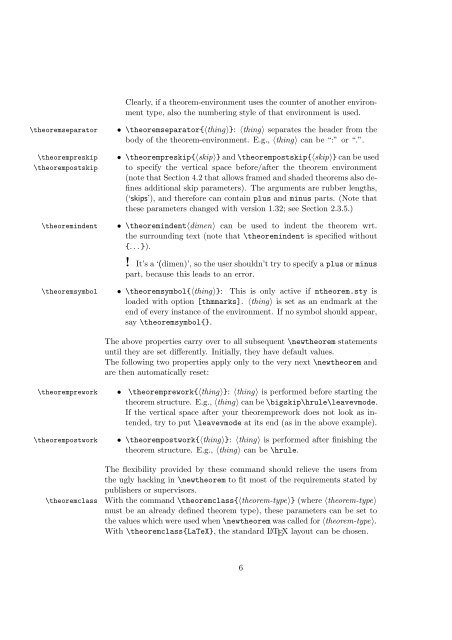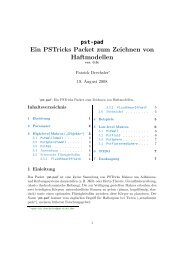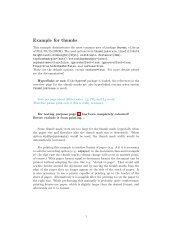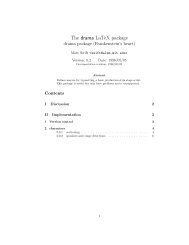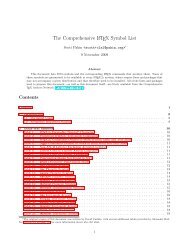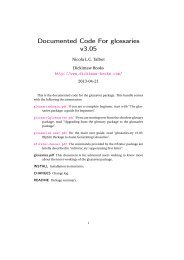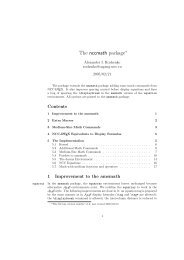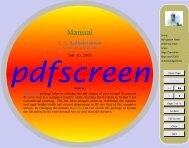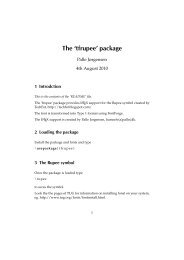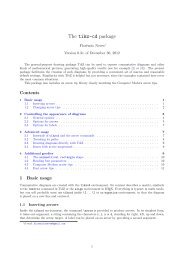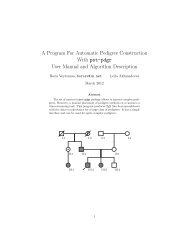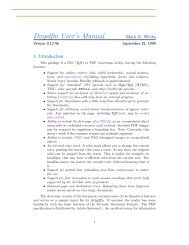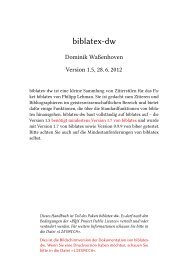ntheorem.pdf. - Mirrors.med.harvard.edu
ntheorem.pdf. - Mirrors.med.harvard.edu
ntheorem.pdf. - Mirrors.med.harvard.edu
You also want an ePaper? Increase the reach of your titles
YUMPU automatically turns print PDFs into web optimized ePapers that Google loves.
\theoremseparator<br />
Clearly, if a theorem-environment uses the counter of another environment<br />
type, also the numbering style of that environment is used.<br />
• \theoremseparator{〈thing〉}: 〈thing〉 separates the header from the<br />
body of the theorem-environment. E.g., 〈thing〉 can be “:” or “.”.<br />
\theorempreskip • \theorempreskip{〈skip〉}and\theorempostskip{〈skip〉}canbeused<br />
\theorempostskip to specify the vertical space before/after the theorem environment<br />
(note that Section 4.2 that allows fra<strong>med</strong>andshadedtheorems also defines<br />
additional skip parameters). The arguments are rubber lengths,<br />
(‘skips’), and therefore can contain plus and minus parts. (Note that<br />
these parameters changed with version 1.32; see Section 2.3.5.)<br />
\theoremindent<br />
\theoremsymbol<br />
\theoremprework<br />
\theorempostwork<br />
\theoremclass<br />
• \theoremindent〈dimen〉 can be used to indent the theorem wrt.<br />
the surrounding text (note that \theoremindent is specified without<br />
{...}).<br />
! It’s a ‘(dimen)’, so the user shouldn’t try to specify a plus or minus<br />
part, because this leads to an error.<br />
• \theoremsymbol{〈thing〉}: This is only active if <strong>ntheorem</strong>.sty is<br />
loaded with option [thmmarks]. 〈thing〉 is set as an endmark at the<br />
end of every instance of the environment. If no symbol should appear,<br />
say \theoremsymbol{}.<br />
The above properties carry over to all subsequent \newtheorem statements<br />
until they are set differently. Initially, they have default values.<br />
The following two properties apply only to the very next \newtheorem and<br />
are then automatically reset:<br />
• \theoremprework{〈thing〉}: 〈thing〉 is perfor<strong>med</strong> before starting the<br />
theoremstructure. E.g., 〈thing〉 canbe\bigskip\hrule\leavevmode.<br />
If the vertical space after your theoremprework does not look as intended,<br />
try to put \leavevmode at its end (as in the above example).<br />
• \theorempostwork{〈thing〉}: 〈thing〉 is perfor<strong>med</strong> after finishing the<br />
theorem structure. E.g., 〈thing〉 can be \hrule.<br />
The flexibility provided by these command should relieve the users from<br />
the ugly hacking in \newtheorem to fit most of the requirements stated by<br />
publishers or supervisors.<br />
With the command \theoremclass{〈theorem-type〉} (where 〈theorem-type〉<br />
must be an already defined theorem type), these parameters can be set to<br />
thevalues whichwereusedwhen\newtheoremwascalled for〈theorem-type〉.<br />
With \theoremclass{LaTeX}, the standard LATEX layout can be chosen.<br />
6


